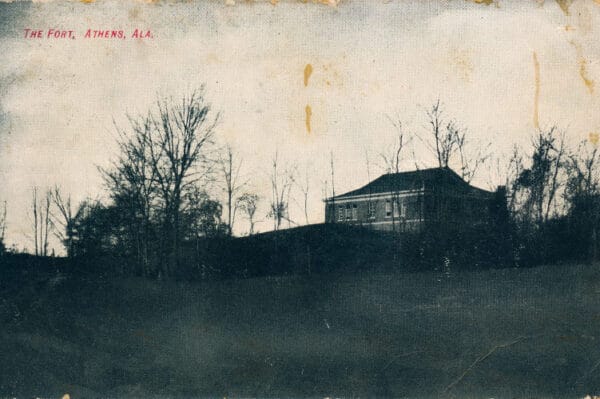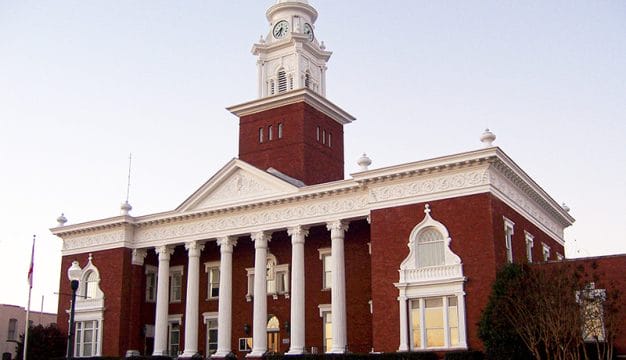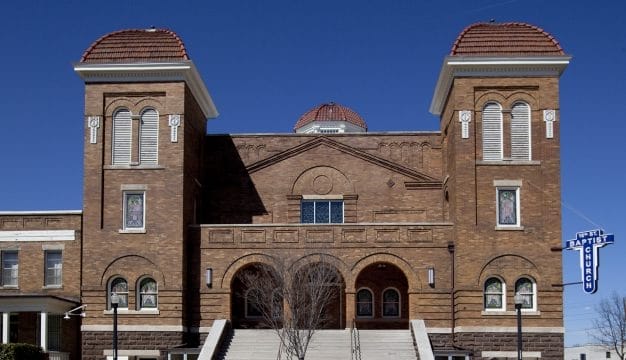Fort Henderson Historic Site
 Fort Henderson Ruins
Fort Henderson Historic Site in Athens, Limestone County, is an earthen fortification constructed by U.S. Colored Troops during the American Civil War. In the fall of 1864, Confederate forces under the command of Gen. Nathan Bedford Forrest captured Fort Henderson and its garrison to disrupt the supply lines of Union general William Tecumseh Sherman, whose army was creating devastation across the South. The fort was soon returned to Union control and eventually abandoned after the war. Shortly thereafter, a school for African American students, named Trinity School, was built upon the ruins of Fort Henderson and later became the first high school for African Americans in the state. It survived until school desegregation forced its closure in 1979. The Athens-Limestone Community Association (ALCA) currently owns the property and is engaged in a multi-phase effort to turn the school and grounds into a community center, a park, and a museum to commemorate the area’s past.
Fort Henderson Ruins
Fort Henderson Historic Site in Athens, Limestone County, is an earthen fortification constructed by U.S. Colored Troops during the American Civil War. In the fall of 1864, Confederate forces under the command of Gen. Nathan Bedford Forrest captured Fort Henderson and its garrison to disrupt the supply lines of Union general William Tecumseh Sherman, whose army was creating devastation across the South. The fort was soon returned to Union control and eventually abandoned after the war. Shortly thereafter, a school for African American students, named Trinity School, was built upon the ruins of Fort Henderson and later became the first high school for African Americans in the state. It survived until school desegregation forced its closure in 1979. The Athens-Limestone Community Association (ALCA) currently owns the property and is engaged in a multi-phase effort to turn the school and grounds into a community center, a park, and a museum to commemorate the area’s past.
In 1862, Union troops under the command of Gen. Ormsby M. Mitchel occupied Athens and work soon began on the construction of Fort Henderson. (Mitchel previously helped plan the daring Union scheme to steal a locomotive and destroy rail lines between Atlanta and Chattanooga that became known as the “Andrews Raid” and “The Great Locomotive Chase.”) Henderson was designed as a five-sided earthen fortification. Its all-white garrison was replaced with the 110th U.S. Colored Infantry Regiment in 1863. Work on the fort continued with the construction of multiple wood-frame buildings and underground bombproof shelters, the digging of an 18-foot moat, and the encirclement of the fort with a network of abatis, or pointed wooden stakes. As Sherman’s army marched through the South in the fall of 1864, Confederate cavalry under Forrest launched a raid on Athens to destroy the Nashville-Decatur Railway, which was part of Sherman’s extensive supply lines.
On September 24, 1864, Confederate forces surrounded the garrison at Fort Henderson and Forrest convinced the garrison commander, Col. Wallace Campbell, that he was surrounded by a far larger force. Seemingly outnumbered, Campbell surrendered his entire 900-man garrison. The next day Forrest’s men would lay siege to another fort protecting a rail line, this one at Sulphur Trestle Bridge just south of Elkmont, and also capture a much larger Union force. It was north Alabama’s bloodiest battle and would also add to the aura surrounding Forrest and his military prowess. Soon thereafter, his forces abandoned the fort and moved north to continue their raids. Union troops quickly reoccupied Athens after his departure.
 Trinity School
Shortly after the war’s 1865 conclusion, the American Missionary Association constructed a school for African American children called “Trinity School” near the former fort. The original building burned to the ground, and the school was reconstructed on the site of the fort in 1907. Trinity School later became Trinity High School, the first accredited high school for African Americans in Alabama and the only school for African Americans in Limestone County. Trinity High School remained in operation until integration prompted its closure in 1979.
Trinity School
Shortly after the war’s 1865 conclusion, the American Missionary Association constructed a school for African American children called “Trinity School” near the former fort. The original building burned to the ground, and the school was reconstructed on the site of the fort in 1907. Trinity School later became Trinity High School, the first accredited high school for African Americans in Alabama and the only school for African Americans in Limestone County. Trinity High School remained in operation until integration prompted its closure in 1979.
The Athens-Limestone Community Association currently owns the property on which the fort and former school stands, to the east of Trinity Park on County Road 29. The organization was established in 1981 with the aim of preserving the fort and the school and promoting their history. Though most of the school’s original buildings no longer exist, the auditorium and a section of the school still stands as does a portion of the fort’s earthworks. The ALCA is currently raising funds to rebuild the fort and create walking trails, interpretive markers, and a park and establish a museum. The ALCA is in the midst of a three-phase restoration program that includes the opening of the Pincham-Lincoln Center community center in 2015 in a renovated portion of Trinity High School, the restoration of Fort Henderson, and the renovation of Trinity High School’s band room into an archives and museum.
Additional Resources
Fulton, Charlotte. Holding The Fort: A History of Trinity School in Athens, Alabama from 1865-1970. Athens, Ala.: Athens-Limestone Community Association, 2014.



